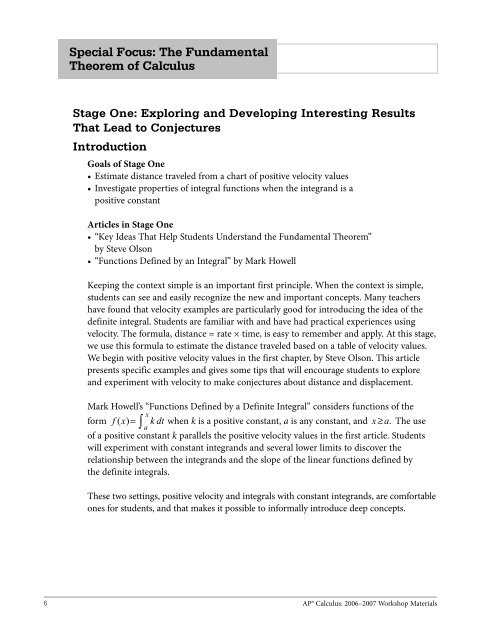AP Calculus
Calculus_SF_Theorem
Calculus_SF_Theorem
You also want an ePaper? Increase the reach of your titles
YUMPU automatically turns print PDFs into web optimized ePapers that Google loves.
Special Focus: The Fundamental<br />
Theorem of <strong>Calculus</strong><br />
Stage One: Exploring and Developing Interesting Results<br />
That Lead to Conjectures<br />
Introduction<br />
Goals of Stage One<br />
• Estimate distance traveled from a chart of positive velocity values<br />
• Investigate properties of integral functions when the integrand is a<br />
positive constant<br />
Articles in Stage One<br />
• “Key Ideas That Help Students Understand the Fundamental Theorem”<br />
by Steve Olson<br />
• “Functions Defined by an Integral” by Mark Howell<br />
Keeping the context simple is an important first principle. When the context is simple,<br />
students can see and easily recognize the new and important concepts. Many teachers<br />
have found that velocity examples are particularly good for introducing the idea of the<br />
definite integral. Students are familiar with and have had practical experiences using<br />
velocity. The formula, distance = rate × time, is easy to remember and apply. At this stage,<br />
we use this formula to estimate the distance traveled based on a table of velocity values.<br />
We begin with positive velocity values in the first chapter, by Steve Olson. This article<br />
presents specific examples and gives some tips that will encourage students to explore<br />
and experiment with velocity to make conjectures about distance and displacement.<br />
Mark Howell’s “Functions Defined by a Definite Integral” considers functions of the<br />
x<br />
form f ( x)= ∫ k dt when k is a positive constant, a is any constant, and x ≥ a. The use<br />
a<br />
of a positive constant k parallels the positive velocity values in the first article. Students<br />
will experiment with constant integrands and several lower limits to discover the<br />
relationship between the integrands and the slope of the linear functions defined by<br />
the definite integrals.<br />
These two settings, positive velocity and integrals with constant integrands, are comfortable<br />
ones for students, and that makes it possible to informally introduce deep concepts.<br />
6<br />
<strong>AP</strong>® <strong>Calculus</strong>: 2006–2007 Workshop Materials


